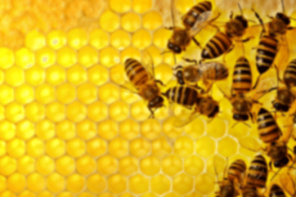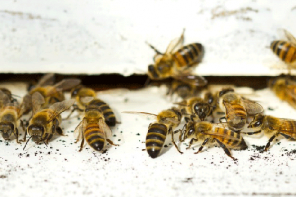By: Jay Evans
Convergent Ways To Expose And Fight Mites
I highlighted three months ago the challenges needed to select for and maintain specific desired traits in honey bees while not losing ground on others, e.g., work on Varroa-sensitive hygiene (VSH) and other resistance traits (https://www.beeculture.com/found-in-translation-15/). The last couple months have seen at least four advances in identifying and selecting these desirable traits. One study compiled insights from four of the best known Varroa-resistant populations, looking for common traits that arise and are maintained when bees are either actively bred for low mite loads or develop mite resistance naturally. These include sustainable mite populations in Norway, Sweden (Gotland) and France. In all cases, a behavioral component appears to help these lineages keep mite levels in check. This study, by Melissa Oddie and colleagues, takes one aspect of hygienic behavior and isolates it from similar defenses (“Rapid parallel evolution overcomes global honey bee parasite”, Scientific Reports, 2018, https://www.nature.com/articles/s41598-018-26001-7). The trait they chose was the frequency of cell uncapping and recapping, without removing brood. Interestingly, simply uncapping the cells and letting bees recap them led to a substantial increase in non-reproductive mites. While they used a creative method to do this in quantity (soaking a piece of linen with wax, letting it adhere to caps and then ripping the lids off), this is not a method beekeepers will do much. Still, it gives insights into the benefits of uncapping, per se. As another creative tool, they recognized that cells that had been uncapped at some point during development showed a characteristic dimple that could be seen and documented at the very end of development. This neat trait allowed them to simply screen mature pupae for mite loads and then infer whether they had been uncapped at some point (saving the eyes of countless students who would otherwise have to stare at an observation hive with capped brood). As expected, the four resistant stocks showed significantly higher recapping rates during development, 3-4-fold more often than the susceptible stocks. Recapping was focused on mite-infested brood, but even non-infested brood was recapped at a higher rate in resistant stock, suggesting a general tendency to look under the hood, or perhaps the presence of other diseases that triggered hygienic behavior. Importantly, the uncapped brood used in these experiments came from a homogeneous set of donor colonies. In other words, it was not that the diseased brood in hygienic colonies were yelling (smelling) louder, but that the workers uncapping and then recapping their cells were somehow more attuned and active. Perhaps the recapping ‘dimple’ can be used by bee breeders as another strategy to breed resistant stock.
Hasan Al Toufailia and colleagues in England recently confirmed experimentally that a key for honey bee hygienics is the ability to recognize what is going on with capped brood (“Both hygienic and non-hygienic honey bee, Apis mellifera, colonies remove dead and diseased larvae from open brood cells”, http://dx.doi.org/10.1098/rstb.2017.0201). In their study, all open brood that was freeze-killed was removed by worker bees within a day, in all lineages of bees studied. This was true across a set of 20 colonies showing a wide spectrum of hygienic tendencies (53%-100% removal of freeze-killed and sealed brood). Similarly, when the youngest larvae were exposed to Ascosphaera apis, the causative agent for chalkbrood disease, all exposed larvae were removed pre-capping. In contrast, when larvae were exposed to A. apis closer to capping only around 30% (‘medium-aged’ larvae) and 15% (larger larvae inoculated a day before capping) were uncapped and removed by workers. Some of these differences in brood removal might reflect resilience of older larvae toward chalkbrood, but the authors argue that colony-level differences in hygienics likely led some colonies to miss or ignore capped disease larvae. So, the hunt needs to be on what makes nurse bees more attuned to their stressed younger sisters while those sisters are covered by a layer of wax.
Seo Hyun Kim and colleagues made headway on determining the cues hygienic worker bees recognize in diseased capped brood. In their 2018 study (“Honey bees performing varroa sensitive hygiene remove the most mite-compromised bees from highly infested patches of brood”, Apidologie, 10.1007/s13592-017-0559-6), bees were more likely to uncap brood to check things out when mite foundresses were not only reproductive but actively so. This has been demonstrated as a key trait of VSH in the past (see work by Marla Spivak and colleagues in the Journal of Neurobiology, 2003, https://doi.org/10.1002/neu.10219), but the current study pushes the science forward by showing exactly when and perhaps how mite reproduction triggers uncapping. Cells with mite offspring, even tiny protonymphs, were uncapped twice as often as cells with just a mite foundress or a foundress with eggs. Once a cell was uncapped, it was more likely that neighboring cells would be uncapped even when accounting for their own mite levels, so bees seemed to be accurately predicting that mites cluster somewhat in small regions of the comb.
Finally, Alison McAfee and colleagues in Vancouver quantified the abilities of two volatile chemicals, β-ocimene and oleic acid, to trigger hygienic behavior by worker bees. While it is not perceived by our noses, oleic acid is a widely used indicator of death throughout the arthropods (insects, crustaceans, mites and the like), meaning that members of these groups have been using this cue to avoid their own demise for 400+ million years (“The ancient chemistry of avoiding risks of predation and disease” Evolutionary Biology, 2009, https://link.springer.com/article/10.1007/s11692-009-9069-4). Other than confirming once again that death stinks, how can these results be used to advance bee breeding? One way is to recognize exactly how bees perceive these two molecules and then determine whether this mechanism can be enhanced via breeding. McAfee and colleagues are well on the way to doing just that, by exploiting a remarkable set of specific proteins that help bees and all of us smell our environment. These aptly named odorant binding proteins (OBPs) are diverse in honey bees and are involved in many aspects of their communication, often being triggered by single molecules that fit them just right. Two OBPs, OBP16 and OBP18, seem to react to β-ocimene and oleic acid and hence are targets for breeding more perceptive bees. The discovery that decades of excellent work on hygienic behavior in honey bees can be refined to specific cues is truly exciting and these insights should aid breeding efforts against some of the worst honey bee foes.










